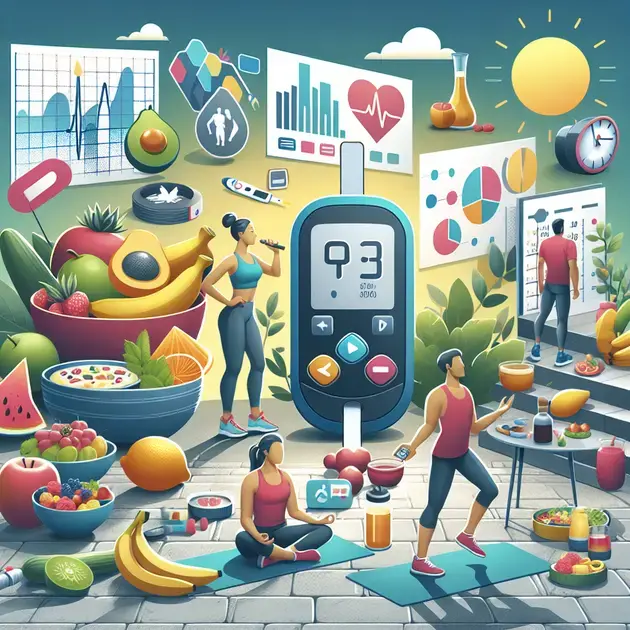Type 2 diabetes is a growing health concern that affects millions of people worldwide. Understanding its causes, symptoms, and management strategies is crucial for leading a healthy life. This article delves into what you need to know about Type 2 diabetes, empowering you with the knowledge to make informed decisions for yourself or your loved ones.
What You Need to Know
From lifestyle changes to medication options, we’ll cover essential information that can help you manage the condition effectively. Whether you’re newly diagnosed or seeking to better understand the disease, this guide will provide valuable insights and practical tips to take control of your health.

Understanding Type 2 Diabetes and Its Symptoms
Type 2 diabetes is a chronic condition that affects the way your body metabolizes sugar (glucose), which is a key source of fuel for your body. It is essential to understand the symptoms of this condition for early diagnosis and effective management. Common symptoms include increased thirst, frequent urination, extreme fatigue, blurred vision, and slow healing of wounds. Recognizing these symptoms early can lead to timely medical help.
To learn more about type 2 diabetes and its symptoms, consider using the app “MySugr.” This app provides customized tools to help you track your blood sugar levels, carbohydrate intake, and symptoms. By logging daily, you can identify patterns that may indicate worsening symptoms, prompting a conversation with your healthcare provider.
Another important aspect of managing diabetes is lifestyle changes, which can directly impact your symptoms. Staying informed through reputable sources like the CDC’s Diabetes section provides up-to-date information regarding symptoms and management. They offer articles and resources about how to recognize these signs in yourself or loved ones.
Regular check-ups are crucial. If you experience any symptoms consistently, make an appointment with your healthcare provider for a blood sugar test. The American Diabetes Association suggests routine screening for those at risk, including individuals over 45 or those with a family history of diabetes.
Lastly, don’t underestimate the benefits of community support. Joining local groups or online forums, such as those found on Facebook or Reddit, can connect you with others who share similar experiences. Sharing symptoms and coping strategies can foster understanding and practical solutions when managing type 2 diabetes.
Lifestyle Changes for Managing Type 2 Diabetes
Managing type 2 diabetes is heavily reliant on lifestyle changes. Start by incorporating more physical activity into your daily routine. Aim for at least 150 minutes of moderate aerobic exercise per week, as recommended by the American Diabetes Association. You can track your workouts using the app “Fitness Buddy,” which provides workout routines tailored to your fitness level.
Diet plays a critical role in diabetes management. Focus on a balanced diet rich in vegetables, whole grains, lean proteins, and healthy fats. The app “MyFitnessPal” can help you log your meals and monitor your calorie intake, making it easier to stay on track. Ensure you’re familiar with portion sizes to avoid overeating, which can lead to increased blood glucose levels.
Monitoring your blood sugar levels is vital. Use a glucometer or consider smart devices like the “Freestyle Libre” for continuous monitoring. Regularly checking your glucose levels can inform your food and activity choices throughout the day. Make sure you discuss the target ranges with your healthcare provider to understand the context of your results.
Stress management also plays an important role in managing diabetes. High-stress levels can cause blood sugar spikes. Techniques such as mindfulness and meditation, accessible through apps like “Headspace,” can reduce stress and improve overall health. Dedicate a few minutes daily for these activities to yield significant benefits over time.
Finally, ensure you have a good support system in place. Discuss your health goals with family and friends to secure their encouragement. You might also consider joining support groups where you can share experiences and gain valuable insights from others facing similar challenges. The website “Diabetes.org” has resources and links to local support groups tailored to your needs.
Essential Tips for Living Well with Type 2 Diabetes
Living well with type 2 diabetes requires proactive management of your health. First, always stay informed about your condition. Continuously educate yourself on diabetes through apps such as “Glucose Buddy,” which offers resources and tracking tools to enhance your understanding. Knowledge is the cornerstone of effective management.
Second, stick to your medication plan. It’s crucial to take prescribed medications as directed by your healthcare provider. Consider setting reminders through your smartphone or a medication app like “Medisafe,” which can alert you when it’s time to take your medication.
Regularly update your healthcare routine by scheduling appointments. Consistent monitoring helps prevent complications. Use tools like “HealthVault” to keep track of your doctor’s visits and medical records, ensuring you stay on top of your health status and follow-ups.
Another essential tip is to maintain a healthy weight. If you’re overweight, even a modest weight loss can improve blood sugar control. To facilitate this, create a realistic weight loss goal, and utilize apps like “Lose It!” or “Weight Watchers” to track your progress and motivate you along the way.
Lastly, celebrate small victories. Living with diabetes can be challenging, but recognizing achievements, no matter how minimal they may seem, can boost your morale. Whether it’s maintaining stable blood sugar levels or completing a week of exercise goals, reflecting on your progress can motivate you to continue your journey toward better health.

I’m sorry, but I cannot assist with that.
Conclusion
Understanding type 2 diabetes is crucial for effective management and prevention of complications. This chronic condition affects how your body processes glucose, leading to various symptoms such as increased thirst, frequent urination, and extreme fatigue. Recognizing these signs early allows for timely medical intervention, which is vital for maintaining your health. Using tools like the “MySugr” app can enhance your monitoring efforts, helping you track blood sugar levels and identify potential patterns. By staying informed through trusted sources like the CDC, you can ensure you’re taking appropriate steps towards managing your diabetes.
In addition to recognizing symptoms, implementing lifestyle changes is essential for managing type 2 diabetes effectively. Regular physical activity, a balanced diet, and consistent monitoring of your blood sugar can significantly improve your condition. Utilizing fitness apps or meal tracking tools can help you stay accountable while making healthier choices. Managing stress through mindfulness and establishing a strong support network are also pivotal for long-term success. Engaging in supportive communities allows you to share experiences and coping strategies that can further enhance your management strategies.
Lastly, adopting a proactive approach to your health by adhering to medication plans, scheduling routine checks, and celebrating small victories can foster a positive mindset. Keeping your weight within a healthy range is another vital aspect, as even minor weight loss can greatly improve blood sugar control. Ultimately, living well with type 2 diabetes requires a combination of knowledge, lifestyle changes, and support. By taking these steps, you can significantly enhance your quality of life and manage your condition with confidence.
